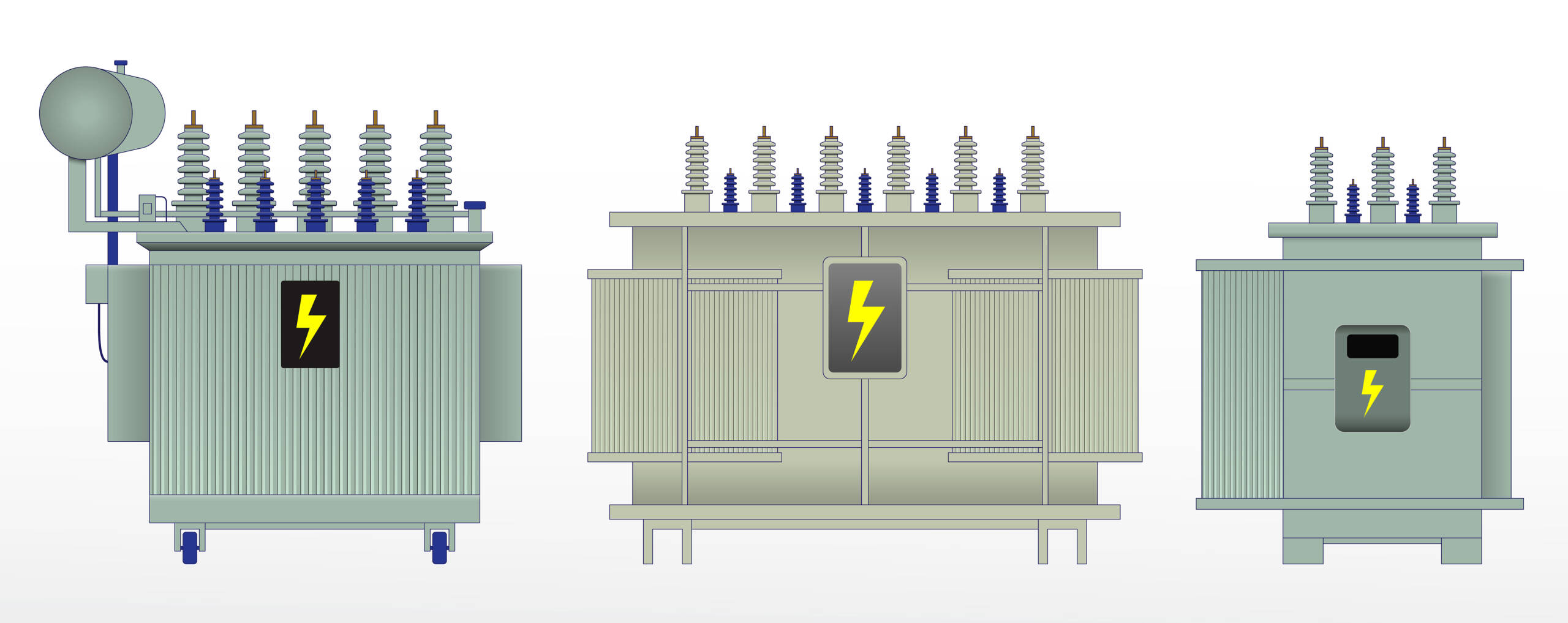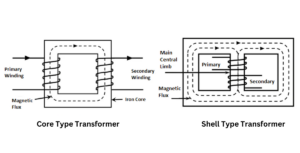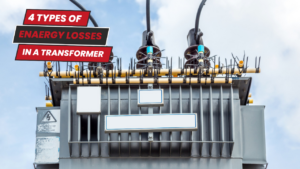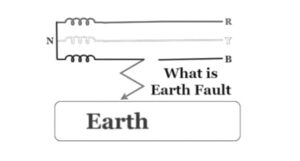Transformers are made up of different components, either it is a power transformer or a distribution transformer, with which they facilitate the efficient transfer of electrical energy between different voltage levels.
Let’s explore the specific functions of different parts of the transformer below-:
- Core: The transformer core provides a low reluctance path for magnetic flux, ensuring efficient energy transfer in power transformers.
- Windings: The windings are responsible for transferring electrical energy between the primary and secondary windings of circuits of a transformer.
- Insulation: Insulation materials prevent short circuits and ensure electrical safety by separating the different components of a transformer.
- Brushing: Brushing is a process used to remove carbon deposits and maintain a clean surface in electrical equipment.
- Tap changer: The tap changer allows for adjusting the turns ratio, enabling voltage regulation in transformers to adapt to varying load conditions.
- Terminals: Terminals provide connection points for external circuits, allowing for the input and output of electrical power in transformers.
- Cooling tube: Cooling tubes facilitate efficient heat dissipation in transformers, preventing overheating and ensuring optimal performance.
- Transformer tank: The transformer parts, like the tank, house the core, windings, and other internal components, protecting them from external factors and providing structural support.
- Breather: The breather is a device that keeps the air inside the transformer tank dry and prevents the entry of moisture, ensuring insulation integrity.
- Explosion vent: The explosion vent provides a safety mechanism that releases pressure in the event of an internal fault or explosion, safeguarding the transformer and minimising damage.
- Buchholz Relay: The Buchholz relay is a protective device used in oil-filled transformers to detect and respond to internal faults, such as insulation failures or the presence of combustible gases.
- Oil Tanks: Oil tanks in transformers serve as reservoirs for insulating oil, which provides insulation, cooling, and heat dissipation. They also act as a barrier to protect the internal components of the transformer.
- Winding Taps: Winding taps allow for the adjustment of voltage ratios by connecting to different points on the windings. They enable transformers to accommodate varying voltage requirements and load conditions.
- Oil Conservator: An oil conservator is a container attached to the transformer tank that allows for the expansion and contraction of insulating oil due to temperature changes. It helps maintain a constant oil level and prevents moisture from entering the transformer.
In Australia, transformers are widely used in various sectors, including power generation, transmission, distribution, industrial processes, and commercial buildings. Based in Malaga, Western Australia, Grant Transformers offers the advantage of local expertise and support. We understand the specific needs and regulations of the Australian market, ensuring compliance and seamless integration of our transformers into your infrastructure.

Basic Components of Transformers and Their Functions
Transformers, often referred to as the workhorses of the electrical industry, play a crucial role in power distribution and utilization. Understanding the different parts of a transformer and its functions is key to comprehending its remarkable capabilities. Let’s learn more about the 14 basic parts of a transformer and uncover how each component contributes to its efficient operation:
1. Core:
The core of the transformer is one of the essential parts of a transformer. It is typically made of laminated magnetic materials, such as iron or steel, and provides a low reluctance path for magnetic flux. The core’s function is to efficiently transfer electrical energy from the primary winding to the secondary winding by minimizing power loss due to eddy currents and hysteresis. The core’s design and material selection are crucial for achieving high efficiency and reducing energy wastage. A well-designed core enhances the transformer’s performance and contributes to a better user experience by ensuring reliable and stable power transmission.
2. Windings:
The windings of the transformer are conductive coils of wire that are wound around the core of the transformer. They play a vital role in transferring electrical energy between the primary and secondary circuits. The primary winding receives electrical energy from the power source, while the secondary winding delivers the transformed voltage to the load. The number of turns in each winding determines the voltage ratio of the transformer. Proper insulation between the windings prevents short circuits and ensures safe operation. High-quality windings with low resistance and optimal design contribute to efficient power transfer and help maintain the transformer’s performance over time.
3. Insulation:
Insulation is a critical component that separates different parts of the transformer, including windings, core, and terminals. It serves multiple functions, such as preventing electrical leakage, ensuring proper insulation, and protecting against short circuits. Insulation materials, such as paper, varnish, or epoxy, are chosen for their dielectric properties and thermal resistance. Effective insulation not only enhances the safety of the transformer but also contributes to its longevity and reliability. By minimising the risk of electrical faults and breakdowns, insulation ensures a smooth user experience and reduces the need for frequent maintenance.
4. Brushing:
Brushing is a maintenance process that involves removing carbon deposits and other contaminants from the surfaces of electrical equipment, including transformers. By keeping the conductive surfaces clean and free of debris, brushing helps prevent issues such as arcing, which can lead to insulation breakdown and transformer failure. Regular brushing improves the efficiency and reliability of the transformer, resulting in an uninterrupted power supply and a positive user experience. It also extends the lifespan of the transformer and reduces the need for costly repairs.
5. Tap Changer:
The tap changer- a mechanism found in some transformers is used for adjusting the turns ratio of the transformer. By changing the connection point on the winding, the tap changer enables voltage regulation, accommodating varying load conditions and ensuring a consistent output voltage. This flexibility is particularly valuable in situations where the input voltage fluctuates or when different voltage levels are required for specific applications. Tap changers enhance the usability of the transformer by providing adaptability and stability in different operating conditions.
6. Terminals:
Terminals are connection points on a transformer that facilitate the input and output of electrical power. They provide a secure interface between the transformer and external circuits, enabling the transfer of energy to and from the transformer. Well-designed terminals ensure efficient power transmission, reducing power loss and maintaining voltage stability. By offering easy and reliable connections, terminals enhance user experience during installation and maintenance activities. Properly labelled and accessible terminals also contribute to safety and ease of use.
7. Cooling Tube:
Cooling tubes, commonly found in oil-immersed transformers, play a crucial role in maintaining optimal operating temperature. They are designed to cool the transformer oil, which helps dissipate heat generated during operation. By removing excess heat, cooling tubes prevent overheating and ensure the transformer operates within safe temperature limits. Effective cooling enhances the transformer’s efficiency and reliability, prolongs its lifespan, and reduces the risk of failures. A well-cooled transformer provides a smooth and uninterrupted power supply, contributing to a positive user experience.
8. Transformer Tank:
The transformer tank is the main enclosure that houses various components of the transformer, including the core, windings, and cooling system. Its primary function is to provide protection and structural support to the internal components. The tank is often made of steel and designed to withstand mechanical stresses and environmental conditions. The tank also serves as a containment vessel for the insulating oil, preventing leakage and ensuring proper insulation. A sturdy and well-sealed transformer tank enhances user experience by ensuring the safe and reliable operation of the transformer.
9. Breather:
The breather is a device attached to the transformer tank that keeps the air inside the tank dry and prevents the entry of moisture. Moisture can degrade the insulating properties of the transformer oil, leading to reduced efficiency and potential failures. The breather contains desiccant material that absorbs moisture from the air that enters and exits the transformer during temperature variations. By preserving the integrity of the insulating oil, the breather helps maintain optimal transformer performance and prolongs its lifespan. Reliable breathers contribute to a positive user experience by ensuring an uninterrupted and reliable power supply.
10. Explosion Vent:
The explosion vent is a safety device installed in transformers to protect against internal faults or the buildup of excessive pressure. In case of an internal fault or a sudden increase in pressure, the explosion vent opens to release the pressure and prevent the transformer from experiencing a catastrophic failure or explosion. This safety feature protects the transformer and surrounding equipment from damage and minimizes the risk of injury to personnel. The explosion vent enhances user experience by providing an added layer of safety and peace of mind, especially in critical applications where the consequences of a transformer failure can be severe.
11. Buchholz Relay:
The Buchholz relay is a protective device typically used in oil-immersed transformers. It is installed in the connecting pipe between the main tank and the conservator tank. The relay detects abnormal conditions within the transformer, such as the presence of gas or significant oil flow, which may indicate internal faults, such as short circuits or insulation breakdown. When abnormal conditions are detected, the Buchholz relay generates an alarm or initiates a trip signal, disconnecting the transformer from the power supply. This protective function helps prevent further damage to the transformer and ensures the safety of personnel. The Buchholz relay contributes to a positive user experience by providing early fault detection and minimizing the impact of faults on the transformer’s operation.
12. Oil Tanks:
Oil tanks are part of oil-immersed transformers and serve as reservoirs for transformer oil. Transformer oil plays a crucial role in insulation and cooling within the transformer. The oil tank provides a secure and sealed container for the oil, preventing leakage and contamination. It also allows for expansion and contraction of the oil due to temperature variations. The oil tank’s design ensures proper circulation and distribution of the oil to cool the transformer and dissipate heat generated during operation. Reliable oil tanks contribute to the longevity and efficiency of the transformer, providing a stable power supply and a positive user experience.
13. Winding Taps:
Winding taps are additional connection points on the transformer windings, allowing for adjustments in the turns ratio and voltage output of the transformer. By connecting to different taps, the transformer’s voltage can be increased or decreased to accommodate specific load requirements or compensate for voltage variations in the power supply. Winding taps provide flexibility in matching the transformer’s output voltage to the load demands, ensuring optimal performance and voltage regulation. This feature enhances user experience by enabling versatility and adaptability in various applications.
14. Oil Conservator:
The oil conservator is an essential component of oil-immersed transformers and serves as a part of the transformer’s cooling and oil maintenance system. The primary function of the oil conservator is to accommodate the expansion and contraction of the transformer oil as its temperature changes during operation. As the transformer heats up, the oil expands, and the excess oil flows into the conservator, maintaining a constant oil level within the main tank. Conversely, when the transformer cools down, the oil contracts, and the conservator supplies the required oil back to the main tank to prevent the formation of air gaps or a vacuum.
What is a Transformer?
A transformer is an electrical device that facilitates the efficient transfer of electrical energy between two or more circuits through electromagnetic induction. It is a fundamental component of electrical power systems, enabling voltage transformation, power distribution, and efficient transmission. Transformers consist of several basic parts mentioned above that work together to perform their essential functions.
Transformers can be classified into:
Power transformers: They are used to step up or down voltage levels in electrical power transmission systems. They have a high-voltage winding connected to the power supply and a low-voltage winding connected to the load. These transformers are commonly used in electricity generation plants and substations to efficiently transfer electrical energy across long distances.
Distribution transformers: Distribution transformers are responsible for voltage transformation and distribution of electrical power to end-users. They typically operate at lower voltage levels, such as 11 kV, 22 kV, or 33 kV, and step down the voltage to levels suitable for residential, commercial, or industrial use.
Transformers have variations based on the number of phases. They consist of core, primary and secondary windings and enable efficient voltage transformation and distribution in electrical power systems. Classification of the types of transformer based on the number of phases are:
- Single-Phase Transformers: Single-phase transformers have a primary and secondary winding and are used in applications where single-phase power is sufficient. They are commonly found in residential and small-scale commercial environments.
- Three-Phase Transformers: Three-phase transformers consist of three sets of primary and secondary windings and are used in three-phase power systems. They are predominant in industrial settings, where large amounts of power are required. Three-phase transformers are crucial for efficient power distribution and utilization in industries, factories, and large commercial buildings.
Our transformers at Grant Transformers are designed with a focus on energy efficiency, minimising losses and reducing environmental impact. By choosing us, you contribute to a greener future while optimising your energy consumption and operational costs. From Consulting, design, and manufacturing to Repair, refurbishing, and upgrading with certifications, we offer you the advantage of local expertise and ensure that our transformers perfectly align with your project requirements!



